Themed collection Editors’ collection: Antimicrobial Polymers

Preparation and applications of peptide-based injectable hydrogels
The recent progress of peptide-based injectable hydrogels for biomedical applications is extensively summarized.

RSC Adv., 2019,9, 28299-28311
https://doi.org/10.1039/C9RA05934B
A functional chitosan-based hydrogel as a wound dressing and drug delivery system in the treatment of wound healing
Functional active wound dressings are expected to provide a moist wound environment, offer protection from secondary infections, remove wound exudate and accelerate tissue regeneration, as well as to improve the efficiency of wound healing.
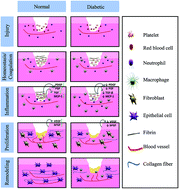
RSC Adv., 2018,8, 7533-7549
https://doi.org/10.1039/C7RA13510F
Antibacterial effect of boron nitride flakes with controlled orientation in polymer composites
Vertically oriented boron nitride flakes on a polymer surface exhibit bactericidal activity.

RSC Adv., 2019,9, 33454-33459
https://doi.org/10.1039/C9RA06773F
In vitro study of chitosan-based multi-responsive hydrogels as drug release vehicles: a preclinical study
Pictorial diagram of multi-responsive hydrogels for controlled drug release system.
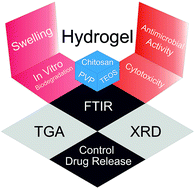
RSC Adv., 2019,9, 31078-31091
https://doi.org/10.1039/C9RA05025F
Antibacterial performance of polymer quaternary ammonium salt–capped silver nanoparticles on Bacillus subtilis in water
Polymer quaternary ammonium salt–capped silver nanoparticles (PQAS–AgNPs) were synthesized, and they exhibited significant antibacterial capacity against Bacillus subtilis.

RSC Adv., 2019,9, 25667-25676
https://doi.org/10.1039/C9RA05944J
Enantiopure polythiophene nanoparticles. Chirality dependence of cellular uptake, intracellular distribution and antimicrobial activity
The use of intrinsic chiral molecules opens the door to bio-imaging specific tools and to the development of target-therapy.
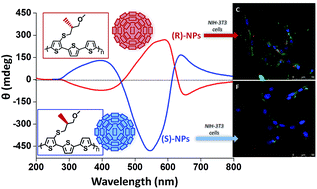
RSC Adv., 2019,9, 23036-23044
https://doi.org/10.1039/C9RA04782D
Enhancement in sustained release of antimicrobial peptide and BMP-2 from degradable three dimensional-printed PLGA scaffold for bone regeneration
One of the goals of bone tissue engineering is to create scaffolds with well-defined, inter-connected pores, excellent biocompatibility and osteoinductive ability.
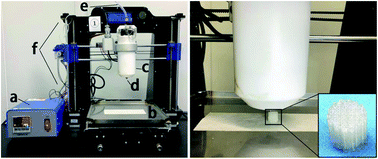
RSC Adv., 2019,9, 10494-10507
https://doi.org/10.1039/C8RA08788A
Nonfouling textiles with tunable antimicrobial activity based on a zwitterionic polyamine finish
Depending on the degree of substitution DS, the antiadhesive (high DS) or antimicrobial (lower DS) character of the coating will be dominant.

RSC Adv., 2019,9, 9783-9791
https://doi.org/10.1039/C8RA09975H
Studies of PET nonwovens modified by novel antimicrobials configured with both N-halamine and dual quaternary ammonium with different alkyl chain length
This work describes the synthesis of novel antimicrobial agents consisting of N-halamine and dual quaternary ammonium with different alkyl chain lengths and their antimicrobial applications for PET nonwovens.

RSC Adv., 2019,9, 7257-7265
https://doi.org/10.1039/C9RA00094A
Surface-attached sulfonamide containing quaternary ammonium antimicrobials for textiles and plastics
A series of surface attached silane or benzophenone sulfonamide quaternary ammonium antimicrobials show potent efficacy at solid/air and solid/liquid interfaces.

RSC Adv., 2019,9, 3140-3150
https://doi.org/10.1039/C8RA10173F
Enhanced bactericidal efficacy of polymer stabilized silver nanoparticles in conjugation with different classes of antibiotics
The paper presents the interaction mechanism of silver nanoparticles (AgNPs) with different antibiotics and the antibacterial efficacy of the formed conjugates.
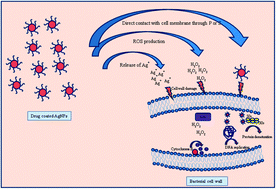
RSC Adv., 2019,9, 1095-1105
https://doi.org/10.1039/C8RA07980C
Incorporation of antimicrobial peptides on electrospun nanofibres for biomedical applications
The aim of this work was to immobilize antimicrobial peptides onto a fibrous scaffold to create functional wound dressings.

RSC Adv., 2018,8, 28013-28023
https://doi.org/10.1039/C8RA03861A
Antibacterial coordination polymer hydrogels composed of silver(I)-PEGylated bisimidazolylbenzyl alcohol
Herein, antibacterial coordination polymer hydrogels were conveniently fabricated in water via coordination between silver nitrate and PEGylated bisimidazolylbenzyl alcohol (1a–c).

RSC Adv., 2018,8, 20829-20835
https://doi.org/10.1039/C8RA00682B
Antimicrobial and optical properties of PET chemically modified and grafted with borane compounds
Polyethylene terephthalate foils were activated with piranha solution and grafted with selected amino compounds (cysteamine, ethylenediamine or chitosan) and then with borane compounds. Their antimicrobial and optical properties were then analyzed.

RSC Adv., 2018,8, 15001-15008
https://doi.org/10.1039/C7RA13502E
Antimicrobial activity of nano-sized silver colloids stabilized by nitrogen-containing polymers: the key influence of the polymer capping
The antimicrobial activity of silver colloids depends on Ag+ kinetic release that is governed by the chemical nature of the polymer coating in polymer-stabilized assemblies.
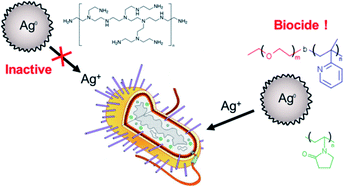
RSC Adv., 2018,8, 10873-10882
https://doi.org/10.1039/C7RA13597A
Construction of a quaternary ammonium salt platform with different alkyl groups for antibacterial and biosensor applications
The immobilized-protein in an appropriate alkyl chain length of DM displayed higher antibacterial activities, exhibited a more effective DET and a promising catalytic activity toward H2O2.
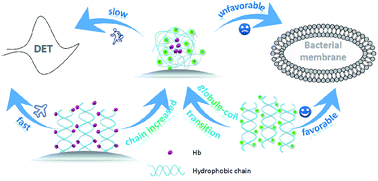
RSC Adv., 2018,8, 2941-2949
https://doi.org/10.1039/C7RA11001D
Development of noncytotoxic silver–chitosan nanocomposites for efficient control of biofilm forming microbes
We describe the synthetic pathway to produce efficient bactericidal, fungicidal and non-cytotoxic chitosan–ascorbic acid–silver composites as solid films.

RSC Adv., 2017,7, 52398-52413
https://doi.org/10.1039/C7RA08359A
Modified polyurethane nanofibers as antibacterial filters for air and water purification
In the present research, we aimed to produce polymer nanofibrous filters for antibacterial purification of air and water and prove their efficiency and stability under simulated filtration conditions.
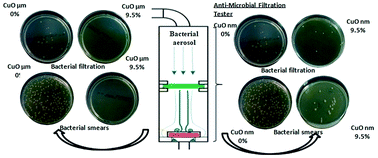
RSC Adv., 2017,7, 49177-49187
https://doi.org/10.1039/C7RA06317B
Antibacterial and biocompatible ABA-triblock copolymers containing perfluoropolyether and plant-based cardanol for versatile coating applications
ABA-triblock copolymers were prepared via ATRP, using modified perfluoropolyether (PFPE) as a macroinitiator (Br–PFPE–Br) to form the B block, and 2-hydroxy-3-cardanylpropyl methacrylate (HCPM) as a monomer to form the A blocks.
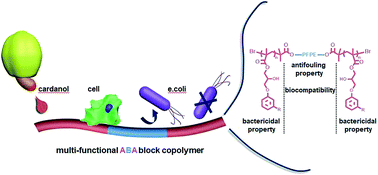
RSC Adv., 2017,7, 38091-38099
https://doi.org/10.1039/C7RA07689D
A sulfonated polymer membrane with Ag-based graft: morphology, characterization, antimicrobial activity and interception ability
Ag-based nano-graft can impart broad-spectrum antimicrobial activity to a polymer membrane and enhance its anti-fouling capacity effectively.

RSC Adv., 2017,7, 37000-37006
https://doi.org/10.1039/C7RA04488G
Facile single-step bioconjugation of the antifungal agent caspofungin onto material surfaces via an epoxide plasma polymer interlayer
We report a facile, one-step, aqueous surface bioconjugation approach for producing an antifungal surface coating that prevents the formation of fungal biofilms.
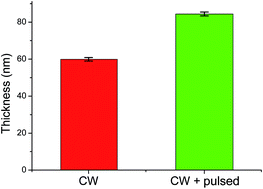
RSC Adv., 2017,7, 27678-27681
https://doi.org/10.1039/C7RA03897F
Development of contact-killing non-leaching antimicrobial guanidyl-functionalized polymers via click chemistry
A new contact-killing and non-leaching antimicrobial polymer was prepared by a robust, efficient and orthogonal click-chemistry.
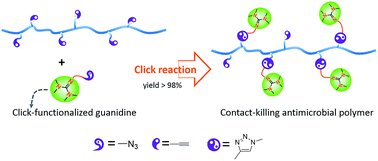
RSC Adv., 2017,7, 24903-24913
https://doi.org/10.1039/C7RA02706K
Synthesis, characterization and antibacterial evaluation of nanofibrillated cellulose grafted by a novel quinolinium silane salt
Nanofibrillated cellulose (NFC) is a bio-based nanomaterial with no intrinsic antibacterial properties.
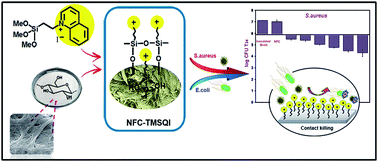
RSC Adv., 2017,7, 23907-23916
https://doi.org/10.1039/C7RA02765F
Rapid bactericidal activity of an amphiphilic polyacrylate terpolymer system comprised of same-centered comonomers with 2-carbon and 6-carbon spacer arms and an uncharged repeat unit
Cationic amphiphilic polyacrylate terpolymers with rapid bactericidal activity against E. coli and S. aureus.

RSC Adv., 2017,7, 10192-10199
https://doi.org/10.1039/C7RA00047B
Preparation of highly efficient antibacterial polymeric films via the modulation of charge density and hydrophobicity
Highly efficient antibacterial polymeric films were prepared in a facile manner via a thiol–ene reaction assisted by ultraviolet radiation.
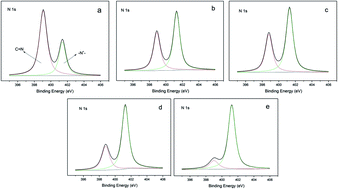
RSC Adv., 2017,7, 6006-6012
https://doi.org/10.1039/C6RA26071C
N-Halamine modified thermoplastic polyurethane with rechargeable antimicrobial function for food contact surface
A TPU elastomer was modified with N-halamine polymers as a novel food contact surface material with rechargeable antimicrobial activity.
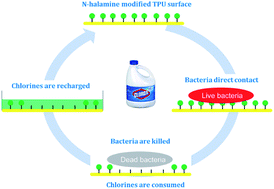
RSC Adv., 2017,7, 1233-1240
https://doi.org/10.1039/C6RA25502G
About this collection
Guest-edited by RSC Advances Associate Editor Professor Roberto Rosal, this collection features remarkable contributions on antimicrobial polymers published in the journal and aims to highlight recent work published on the design, characterization, and efficiency of antimicrobial polymers.
Antimicrobial polymers are materials aimed at inhibiting or killing different types of microorganisms. The importance of developing new antimicrobial substances and materials arises from the health problem posed by multidrug-resistant microbes.
This set of articles describes some recent developments on the use of different types of antimicrobial polymers. They include antimicrobial nanomaterials, antimicrobial fibres and surfaces and drug-delivery systems with a focus on potentially pathogenic bacterial strains.